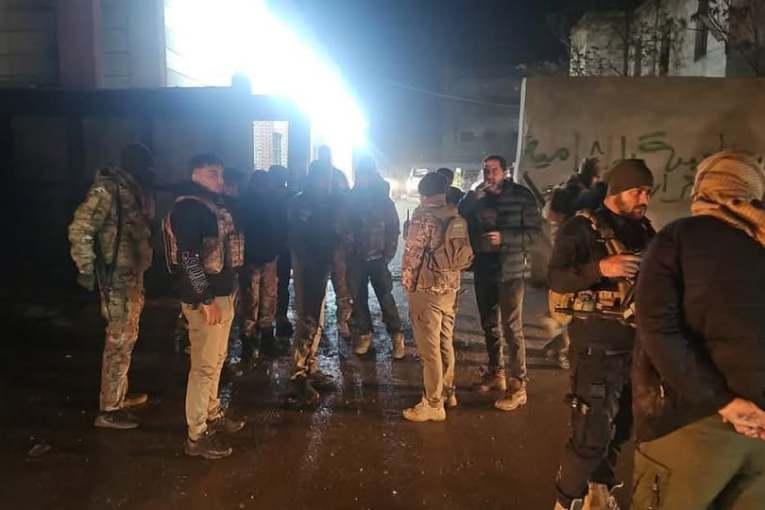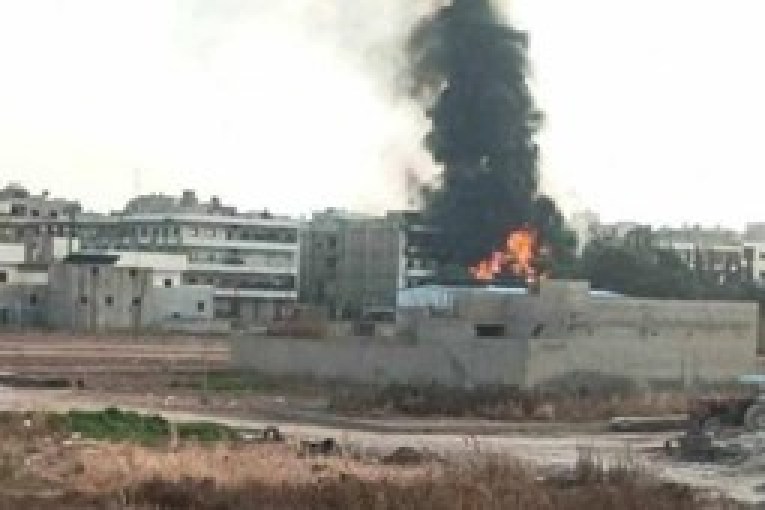
Afrinpost – Special
The difference is big between the theft of archaeological objects and archaeological finds and the theft of history itself. The Turkish occupation authorities and its Islamic militias associated with the Muslim Brotherhood, with the occupation of the Kurdish region of Afrin, began a focused campaign aimed at research and excavation of antiquities, and included all the hills and archaeological sites, and the soil was razed and the features of those sites were changed. The site of Nabi Huri (the city of Cyrrhus) suffered the largest of excavations and deliberate vandalism, while the occupation promotes restoration work at the site, as it did in the Ottoman Mosque in (2018), then vandalized it again.
Stealing history
From time to time, the Turkish occupation authorities publish pictures of Nabi Huri site to publicize the maintenance and restoration work at the site, and the preservation of antiquities, contrary to the facts on the ground, as Nabi Huri constitutes the largest archaeological site that has been destroyed.
During the past two days, social media has circulated recent photos of Nabi Huri, and restoration and beautification work has been introduced into it, but publishing the images is to cover up another larger operation that took place in the vicinity of the mosque, which is the theft and erasure of history by leveling an area of more than 2 km in diameter. .
The Directorate of Antiquities in Afrin Canton, in its report dated 10/28/2020, mentioned general information about the site of Cyrrhus, which is known by other names such as (Cyrus – Cyrrhus – Nabi Huri), and that its remaining traces belong to several ancient civilizations, the oldest of which are from the Hellenistic period (Seleucid) About (280 BC), then the Roman period (64 BC), Byzantine and then Islamic, and it is one of the defunct cities that the Seljuk ruler Nur al-Din Zangi put an end to its history and civilization in the middle of the 12th century (AD).
The largest area of any archaeological site to be destroyed
After the Turkish occupation of the Kurdish region, the site was subjected to the fiercest illegal excavation campaign that targeted it and bulldozed the soil. “The city was subjected to violent Turkish bombardment due to its proximity to the Turkish border since the first day of the Turkish attack on the Syrian region of Afrin on (20/1/2018). After its occupation, its antiquities were exposed to the most heinous violations.
The Directorate made a comparison between the visual documents that it received dated from (10/8/2018, 6/10/2018, 3/11/2018, 11/15/2019 and 6/23/2020) that prove the Turkish authorities and their affiliated militias (Suqur al-Shamal faction in particular) ) carrying destructive and random excavations with heavy machinery (bulldozers) that led to the destruction of the archaeological layers without documenting them, in addition to the destruction of fragile archaeological materials such as glass, ceramics, pottery, mosaic paintings … etc. ”. And continued: “We did not have sufficient information about the size of the sabotage excavations and the areas affected by the excavation operations as a result of closing the site to the general public, as the process of documenting violations of archaeological sites is obstructed by several factors that contribute to the inability to form a clear picture of the situation. This point was mentioned in the report of the international investigation committee on Syria issued on 9/14/2020.
The report continued: “On 10/26/2020, we obtained a satellite image dating back to 9/28/2019, which shows the path of the sabotage excavations carried out by the pro-Turkish factions in cooperation with the Turkish authorities and the areas that were excavated up to the date of the satellite image 9/28/ 2020, it appears in the picture that the excavation operations were carried out with heavy machinery on vast areas of more than sixty hectares (60) hectares (within a circle of 2 km in diameter) in addition to unknown areas within the city wall at the eastern and southeastern ends between olive groves and the southwestern end, according to testimonies, and this is the largest area that was systematically vandalized in the history of the destruction and vandalism of archaeological sites and human cultural heritage. We do not have a clear idea of the percentage of damage to the site and the archaeological pieces that emerged as a result of these sabotage excavations and their fate, especially the mosaic paintings that we documented on 11/18/2019 and 28 / 11/2019, where we documented the violations occurring on the site according to the documents received in previous years, and we published them successively, and the events that we previously documented agree with the satellite images, such as the issue of mosaic panels which was published on 11/6/2019 on the page of one of the workers in the field of sabotage and destruction of the antiquities of the Syrian region of Afrin, and at that time we prepared several reports regarding the issue of mosaic paintings and the attempt to falsify the truth and mislead the public opinion, and it is worth noting that the excavation work is still continuing until now.
Thus, the first goals of the soil razing and restoration operations are to cover the violations that took place on the site and the thefts that took place there, and begin with the theft of archaeological finds and paintings to the theft of history itself, by leveling the soil so that no material evidence remains indicating its history. Thus, the occupation steals and erases the history and the original identity of the region.
Manipulating historical significance
The project to restore monuments and mosques comes within the framework of a seemingly religious, political and ideological scheme aimed at supporting Turkish influence through the portal of religious institutions. Its aim is to evoke the image of the Ottoman Empire as the last stage of the Islamic Caliphate, and to promote the idea that present Turkey is the legitimate heir of that state, and the restoration policy comes within the plan of investing Turkish soft power across the world, to present Turkey’s image as a moderate Islamic state in contrast to extremism and militancy.
What Ankara is seeking precisely through restoration is the reformulation of the cultural and social memory, because for every force of incitement, it invokes specific concepts and incidents, and what Ankara wants is a facelift of the Ottoman era that is about to revive it, and on this basis it changes the spatial situation to bring about a direct change in the intellectual stock .
On 5/15/2020, the Directorate of Endowments of the Turkish Province of Hatay announced the restoration of the archaeological shrine of “Nabi Huri”, and the Omar Ibn Al-Khattab Mosque in Afrin. “The General Directorate of Endowments attaches great importance to the restoration and revival of antiquities left by ancestors in Syria, as is the case in Bosnia and Herzegovina, Kosovo and North Macedonia,” said the director of Hatay endowments, Umit Gökhan Çiçek, at a press conference.
It is natural that the restoration work in the Nabi Hori Castle will not aim to bring about a fundamental change in the shape, but rather in its historical significance and revelations. The site is an important historical witness that has been neglected, despite its priceless archaeological treasures, and it was in a miserable state, but the restoration aims to turn it into a tourist landmark for recreation with economic rent, and to give it Ottoman touches.
Thus, the plan is completed in two phases: changing the features and promoting tourism, without an identity related to the Hurrian and Kurdish history, and it is certain that the plan is long and does not target the current generation, but with the demographic change plan in the region that takes additional dimensions, during which the occupation’s intentions are clarified by directly linking the region’s culture with Turkish culture.















